Moving Woodpeckers

Grace Starts 2016 in Maryland Jan 2, 2016
January 4, 2016Deciphering the winter composition of sharp-tailed sparrows
January 6, 2016
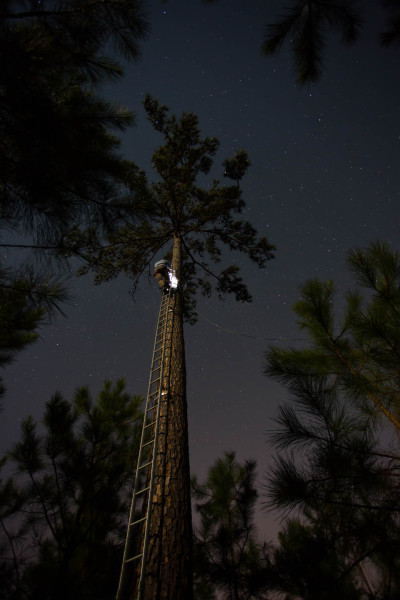
Bryan Watts climbs into pine tree to replace cavity screen. Photo by Bobby Clontz.
The stars had just bloomed over the pines as I climbed forty feet up into a tree to replace a cavity screen. Pleiades had emerged from the distant glow of the Norfolk skyline and was sailing north. Standing in the tree with all the lights off, I was suspended between the black void of the swamp below and the brilliant sky above. After more than a decade of wishful thinking and months of planning, preparation, and paperwork, the move was finally underway. Teams of biologists from across five states had been set in motion to capture and move woodpeckers. Later this night they would converge on the Great Dismal Swamp National Wildlife Refuge in a historic effort to establish a new population of the federally endangered red-cockaded woodpecker.
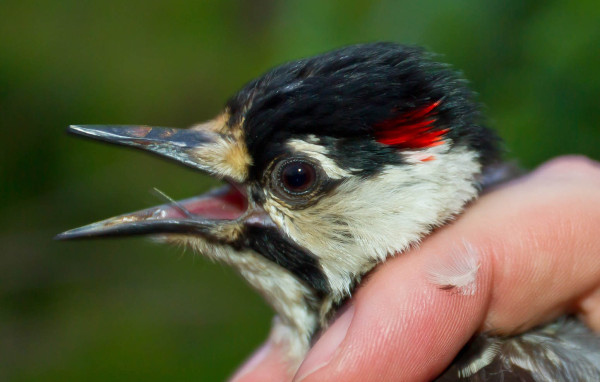
A male red-cockaded woodpecker showing its distinctive but rarely seen red feathers. Photo by Bryan Watts.
Virginia supports the northernmost population of red-cockadeds. Because the single, small population located within the Piney Grove Preserve is vulnerable to catastrophic events, the Virginia Recovery Plan has long called for the establishment of additional populations. If successful, the Dismal Swamp population would represent a milestone in the recovery of the species around the northern periphery of its breeding range.
Making Preparations
Preparations for the move have been years in the making and included habitat management, site selection, cavity installation, work with donor populations, and identification of candidate birds.
In recent years, staff of the Great Dismal Swamp National Wildlife Refuge has been working to prepare habitat to support the woodpeckers. During the summer, biologists delineated eight forest areas that would receive the birds and hopefully support breeding territories into the future. Students with the AmeriCorps program would do some of the heavy lifting and cut trails through swamp vegetation into selected sites. Late in the summer, Bobby Clontz and Tim Sanjule from The Nature Conservancy installed artificial cavities in four pines within each of these eight locations. The introduced birds will use the artificial cavities for roosting until they are able to excavate their own natural cavities. In the week running up to the move, we “cleared” the artificial cavities and placed a screen over each entrance to insure that no interlopers would be inside when the birds were placed.
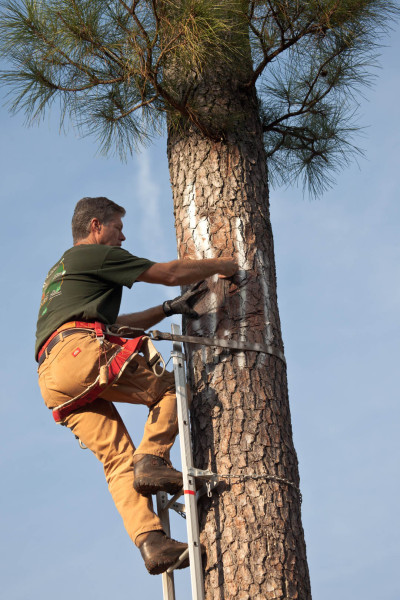
Bobby Clontz installs cavity screen in the week running up to the woodpecker move to prevent access by cavity competitors. Photo by Bryan Watts.
The woodpeckers were scheduled to be taken from two “source” populations, including Carolina Sandhills National Wildlife Refuge near McBee, SC and Palmetto-Peartree Preserve near Columbia, NC. Birds within both populations had been monitored during the spring breeding season and individuals were color-banded for later identification. Late in the summer, individual males and females were identified as candidates for the move based on the spring production figures.
In early September, teams of biologists converged on donor sites to locate designated candidate birds and to determine where they were roosting. On 21 October, just days before the actual move, teams of biologists convened onsite once again to relocate birds in preparation for the move. Over the next two days, target and backup birds were identified and “roosted” to facilitate capture and to insure that everything was fully prepared for move day.
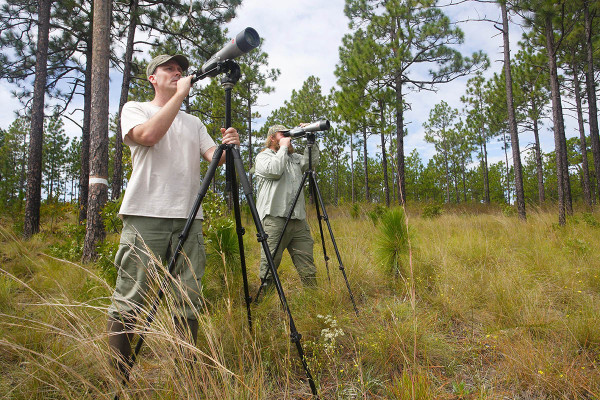
Mike Wilson (left) and Fletcher Smith (right) use spotting scopes within Carolina Sandhills National Wildlife Refuge to identify target birds and they come into roosts. Photo by Bart Paxton.
After all of the target birds, backups, and backups to backups had been roosted within the donor populations, Will McDearman, the national recovery coordinator and commander of the move, gave the green light. The move was scheduled for Thursday night, the 23rd of October, and would involve more than 35 people from multiple agencies and organizations.
The Move
Woodpeckers would be captured just after they entered their roost cavities at dusk, placed in custom carrying boxes, driven north, and then placed in new cavities to be released into their new habitat at dawn. Eight birds in total including four hatch-year males and four hatch-year females would be moved. One male and one female would be taken from Palmetto-Pairtree Preserve and the remaining birds would be taken from Carolina Sandhills.
The declaration by McDearman would set in motion orchestrated capture plans within the donor sites and placement plans within the swamp. On the afternoon of 23 October, Nancy Jordan, woodpecker biologist for Carolina Sandhills and field general for the South Carolina operation, would rally the troops, break them into ten teams, and deploy them to their assigned locations. Jan Goodson would do the same in North Carolina. By late afternoon, teams were in position and waiting for target birds to roost.
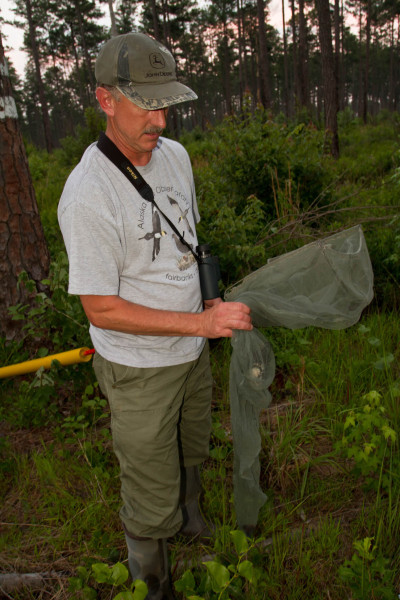
Dana Bradshaw holds a red-cockaded woodpecker captured with a cavity net within the Piney Grove Preserve. This same net type was used to capture birds for translocation to the Great Dismal Swamp. Photo by Bryan Watts.
Efforts were focused on the safe capture of the target birds. As birds entered roost cavities, net handlers moved to the base of roost trees, raised nets on telescopic poles to cavities, and enticed birds out into nets. Birds were removed from nets and their identities were confirmed by reading their bands before they were placed in carrying boxes. Within an hour and a half after sunset, radio communication would confirm that all eight birds were safely in hand leading to a collective sigh of relief across three states.
Capture teams geared up and prepared for the long convoy north to the Great Dismal Swamp where they would rendezvous with additional teams in the refuge bunkhouse. All birds were assigned to specific cavity trees and teams had been assembled to place them into artificial cavities.
The North Carolina team, including Matt King and Jaan Kolts, made their arrival by 9:30 PM and were quickly dispatched on the forty-five minute drive through the swamp to recruitment cluster YCC1. With assistance from a Virginia crew they used Swedish climbing ladders to climb trees and placed the male in cavity 03 and the female in cavity 04. Screens were tacked over the entrances to hold the birds in cavities until “release” the following morning. Climbing ladders were broken down and moved to other sites to be used later in the night.
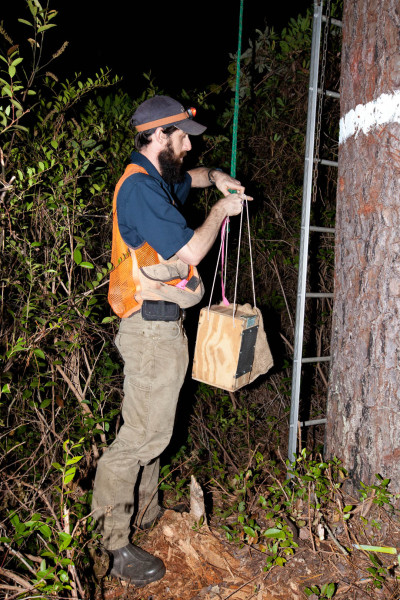
Matt King attaches a woodpecker box to a drop line so that it may be raised into the tree and placed in artificial cavity. Photo by Bryan Watts.
The South Carolina teams pulled into the bunkhouse parking lot just after 2:00 AM. Placement teams were assembled and convoyed out to the three remaining recruitment clusters. Birds were placed in their assigned trees and screened in by teams working simultaneously and all birds were safely in place by 3:45 AM. Shanghaied from their natal territories, they would now have less than four hours of sleep before being released into a new site.
The Release
Release of birds into new environments is an exciting event and the young woodpeckers were released into the swamp by simply pulling cords to remove the screens. Red-cockadeds in Virginia typically emerge from cavities around official dawn, which on this day was 7:20 AM. Release teams were deployed from the bunkhouse by 6:15 AM and were in place within the woods by 7:00 AM. Teams consisted of screen pullers and observers with the objectives of safely releasing the birds, observing their behavior, and minimizing disturbance.
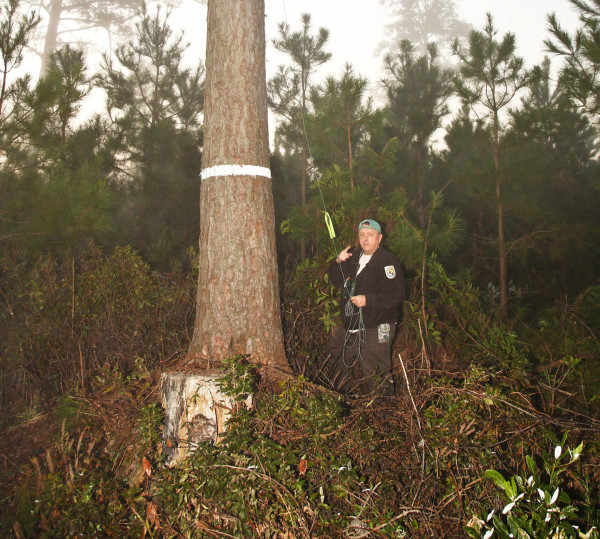
Don Schwab counts down to pull the screen cord and release a male woodpecker. Photo by Bart Paxton.
All of the birds flew strongly out of cavities and were calling when released. The female released in cluster C3 flew directly up into the crown of an adjacent tree and began foraging and calling to make contact with other birds. She then foraged through the trees in an arc around the cluster and was joined by the male in the third tree she visited. Both birds were calling and foraging when the team left them after twelve minutes. Walking out of the woods after a long night, all of the teams were excited to have seen the birds interacting with their new habitat.
Woodpeckers were released from artificial cavities by pulling the screen cord to open the cavity. All birds came out beautifully and began calling for other woodpeckers immediately. Video by Bobby Clontz.
Follow-up Status
Following release on the morning of 24 October, the birds were left to settle in for more than a month with no human contact. They were left to their own devices to stay or go, to choose their own relations, their own recruitment clusters, their own roost cavities, and to define their home ranges.
On 10 December, a team lead by Mike Wilson and including Bart Paxton, Fletcher Smith, and Kelly Morris, would begin a systematic assessment of the birds that remained in the swamp. Over several days they would move through each cluster to see if birds emerged from cavities at dawn or entered at dusk. They would use spotting scopes to read color-band combinations in order to identify all birds associated with clusters.
Although the birds had shuffled locations and relationships, six of the eight birds released on 24 October remained within recruitment clusters. This includes four females (all of those released) and two males. The sole male moved from North Carolina was absent and one of the males from South Carolina was not found. A promising sign was that one of the remaining males was roosting in a cluster with two females and the other male was joining up and foraging with a solitary female.
The Future
With the successful release of eight birds into the Great Dismal Swamp National Wildlife Refuge and the retention of six of these birds, including two potential pairs, a decade of wishful thinking was concluded. However, success will be measured in the future by the establishment of stable and productive breeding sites. We remain hopeful and will be watching this spring.
Regardless of what happens in the future, the successful translocation of woodpeckers from donor sites in the Carolinas to the Great Dismal Swamp represents a testament to what may be achieved through collaboration among dedicated biologists and agencies. The project had a lot of moving parts and success required that many things go right. This would not have been possible without the dedication and enthusiasm of many people. We thank staff from the Great Dismal Swamp, NWR, Carolina Sandhills, NWR, SD Hamilton Noxubee, NWR, Okefenokee, NWR, two USFWS ecological services offices, Jay Carter and Associates, Inc., Virginia Department of Game & Inland Fisheries, The Nature Conservancy, The Center for Conservation Biology, and many volunteers.
More Photos:
[easy_image_gallery]
Written by Bryan Watts | bdwatt@wm.edu | (757) 221-2247
January 5, 2016



